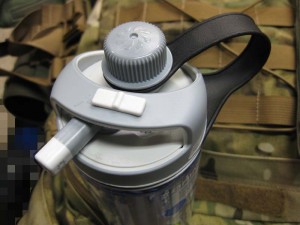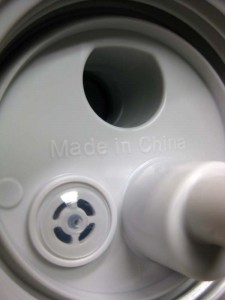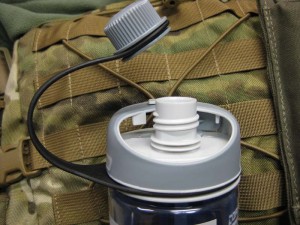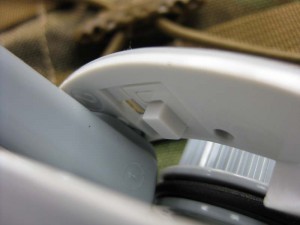 Ever since the demise of my Camelbak Better Bottle, I’ve been waiting expectantly for the release of Nalgene’s entry into the straw-bottle market. The prototype began appearing online on gear blogs at the end of last year and trade shows at the beginning of the year, with the production model supposedly hitting the shelves by mid-year. For a long time they were vaporware and didn’t even appear as line items on order sheets. Only now are they starting to trickle into retailers. The bottle itself doesn’t even appear on Nalgene’s site at the time of this post! McBike just got their first shipment in, so here’s a brief rundown from a cursory inspection. The bottle itself is 600ml (20-ounce), and is about the same height as the standard 1-liter bottle, but has a reduced diameter. The mouth is the standard Nalgene “wide mouth”. The BPA-free plastic bottle is made in The USA.
Ever since the demise of my Camelbak Better Bottle, I’ve been waiting expectantly for the release of Nalgene’s entry into the straw-bottle market. The prototype began appearing online on gear blogs at the end of last year and trade shows at the beginning of the year, with the production model supposedly hitting the shelves by mid-year. For a long time they were vaporware and didn’t even appear as line items on order sheets. Only now are they starting to trickle into retailers. The bottle itself doesn’t even appear on Nalgene’s site at the time of this post! McBike just got their first shipment in, so here’s a brief rundown from a cursory inspection. The bottle itself is 600ml (20-ounce), and is about the same height as the standard 1-liter bottle, but has a reduced diameter. The mouth is the standard Nalgene “wide mouth”. The BPA-free plastic bottle is made in The USA.

 The cap is marked “Made in China” on the inside. Although seemingly sturdily made, the cap is underwhelming. Easily the best designed and best constructed of all the straw-style caps on the market now, it is not without issues. The cap has both a straw and small cap to allow the user to either “sip” or “gulp” (hence the “multi drink” moniker). The cap is tethered by a flexible polymer retainer that goes between rings on the bottom edge of the cap and around the outer circumference of the cap body. The retainer appears to be made of a pebbled-finished material more like resin watchbands rather than the LDPE that standard Nalgene screw cap tethers are made from. There are curiously rings also on the neck that the cap threads onto, perhaps a vestige of an earlier tethering design. The straw swings out of the side of the cap, rotating on a longitudinal axis, as opposed to most other designs that rotate on a horizontal axis. This is in order to operate a rotational offset valve at the base of the straw – turn the straw out, and the holes in the valve line up and you can drink: Turn the straw in, and the holes misalign and water cannot flow. From the resistance, there are probably o-rings or lip seals sealing both the rotating barrel and the offset valve. There is a bridge of plastic over the straw to protect it from the top, and to form a recess for the straw to sit within when closed.
The cap is marked “Made in China” on the inside. Although seemingly sturdily made, the cap is underwhelming. Easily the best designed and best constructed of all the straw-style caps on the market now, it is not without issues. The cap has both a straw and small cap to allow the user to either “sip” or “gulp” (hence the “multi drink” moniker). The cap is tethered by a flexible polymer retainer that goes between rings on the bottom edge of the cap and around the outer circumference of the cap body. The retainer appears to be made of a pebbled-finished material more like resin watchbands rather than the LDPE that standard Nalgene screw cap tethers are made from. There are curiously rings also on the neck that the cap threads onto, perhaps a vestige of an earlier tethering design. The straw swings out of the side of the cap, rotating on a longitudinal axis, as opposed to most other designs that rotate on a horizontal axis. This is in order to operate a rotational offset valve at the base of the straw – turn the straw out, and the holes in the valve line up and you can drink: Turn the straw in, and the holes misalign and water cannot flow. From the resistance, there are probably o-rings or lip seals sealing both the rotating barrel and the offset valve. There is a bridge of plastic over the straw to protect it from the top, and to form a recess for the straw to sit within when closed.
The straw was firmly attached to the underside of the cap. I didn’t want to break the cap and end up having to buy it, so I didn’t really go at it to see if the straw really was permanent or just installed freakishly tight. If it doesn’t come off, I foresee cleaning issues, both with the straw and valve. This would also be an issue if using the cap with a different height Nalgene bottle as a longer straw couldn’t be fitted.
 The straw has a safety lock to keep the straw valve closed to prevent leakage. This is superfluous, since the friction on the valve is too great for inertia to overcome unless the bottle is dropped, so it is highly unlikely that the valve will accidentally open. The sliding lock itself is not robustly constructed and appears to be an afterthought. It is essentially a rectangular piece of plastic with a tab that extends down through a hole in the bridge that protects the valve. It is retained in the bridge by another rectangular piece of plastic that snaps on from the underside, sandwiching the lock onto the bridge. The bridge is slotted to allow the lock to slide from side to side. In the “lock” position, the tab interferes with a web of plastic on the pivot-end of the valve. Considering this is where the leverage applied to the lock is the highest, it is the least desirable place for a latch. If the valve is pulled when the lock is engaged, the plastic tab deflects significantly. The amount of overlap between the tab and web is not a whole lot, so a moderate pull on the valve would probably turn the straw out even with the lock engaged. From the amount of flex, I’d guess that about three times the force used to open the unlocked valve would force the locked valve open. About one or two force-open events is probably all that would be needed to make the lock fail permanently. Again, I didn’t want to buy it, so I didn’t empirically test the lock to the point of failure. The locking mechanism should have been designed to block the tip of the straw where the leverage is the lowest, and would serve the double duty of helping to keep the straw tip clean.
The straw has a safety lock to keep the straw valve closed to prevent leakage. This is superfluous, since the friction on the valve is too great for inertia to overcome unless the bottle is dropped, so it is highly unlikely that the valve will accidentally open. The sliding lock itself is not robustly constructed and appears to be an afterthought. It is essentially a rectangular piece of plastic with a tab that extends down through a hole in the bridge that protects the valve. It is retained in the bridge by another rectangular piece of plastic that snaps on from the underside, sandwiching the lock onto the bridge. The bridge is slotted to allow the lock to slide from side to side. In the “lock” position, the tab interferes with a web of plastic on the pivot-end of the valve. Considering this is where the leverage applied to the lock is the highest, it is the least desirable place for a latch. If the valve is pulled when the lock is engaged, the plastic tab deflects significantly. The amount of overlap between the tab and web is not a whole lot, so a moderate pull on the valve would probably turn the straw out even with the lock engaged. From the amount of flex, I’d guess that about three times the force used to open the unlocked valve would force the locked valve open. About one or two force-open events is probably all that would be needed to make the lock fail permanently. Again, I didn’t want to buy it, so I didn’t empirically test the lock to the point of failure. The locking mechanism should have been designed to block the tip of the straw where the leverage is the lowest, and would serve the double duty of helping to keep the straw tip clean.
On the inside of the cap is a clear silicone breather diaphragm similar to the breather flap on the Camelbak bottle. The cap is constructed in two parts. The lower, inner part has the cap threads and the roof of the inside of the cap. The upper, outer part has the grippy rubberized outer surface and straw bridge. The two parts snap together, and there are no threaded fasteners holding it together.
I’m not particularly impressed. Considering the time it took them to get it to market, I was expecting something more thoroughly thought-out and massaged. In the interim between the death of my Camelbak bottle and now, I got one of Nalgene’s OTG (On The Go) flip-top bottles, and I’m used to that system already. The 100% US-made OTG is much lighter, and the cap is sufficiently leakproof for EDC or hiking. The only times I’ve had the cap pop open was when I dropped the bottle, and then that was just two times out of many drops.
About $12 USD street price
Somewhat Recommended (if you crave a straw-type bottle, this is definitely the way to go)
Made in The USA (bottle) / Made in The PRC (cap)
Two out of four hydrated gear monkeys.
0 Responses to “Nalgene Outdoor Multi Drink Bottle”